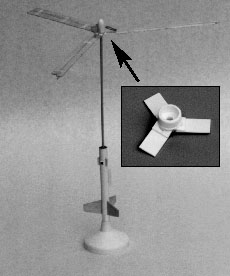Apogee Components Micro Whirl-A-Tron
Apogee Components - Micro Whirl-A-Tron {Kit} (5023)
Contributed by David Urbanek
| Diameter: | 0.45 inches |
| Manufacturer: | Apogee Components  |
| Skill Level: | 5 |
| Style: | Helicopter |

(Contributed - by David Urbanek)
 Brief:
Brief:
A high performance, contest quality helicopter rocket. No burn strings here!
Construction:
Materials were strictly top shelf. Body tube, vacuformed nose cone, balsa fins
and rotor blades. Especially important is the molded hub and piston. You might
consider buying this rocket just for the quality parts. The instructions are
very good and lead you through logical. The trickiest steps concern making sure
you don't glue the fold-in-half rotor blades to themselves. Assembly is
straightforward, though intricate. When you're done the rocket will look
insanely tiny and light and make you think of competition records that will
fall, but there is a catch...
The instructions are very thorough, as you would expect, from Apogee. The rotor blade fold in half lengthwise and are set up on a template. Take great care that you get the hinge side and the elastic sides correct. To keep the edges of the rotor blades from sticking along the seam, Apogee suggests vaseline carefully applied to the joint. Excellent suggestion. Also take care to trim the dowel that runs up the middle to the proper length. This model should be easily built with the tools and glue that you already have for other rockets. This is NOT a beginner's rocket.
Finishing:
This is a contest rocket, finishing is not a great idea. However, somethings
will help it's visibility. Try using magic markers and/or highlighters to add
color.
Construction Rating: 4 out of 5
Flight:
Flight is where this rocket has problems. It is simply unstable if there's any
wind. My Micro Whirl-A-Tron and several others have looped when they flew. The
basic dimensions of the rocket are those of the Centrix, which flies great, but
the cast piston moves the CG too far back to make this rocket anything but a
Micro Loop-A-Tron in the wind. Two flights with Apogee 1/2A2-4 motors and 1
with 1/4A2-4 all looped during the afternoon lull at NARAM 42. I saw a few
other's fall into the same trap. I did see one that worked, but the flyer had
extended the fin span by 3/4". Prep is easy, fold the rotors, place them
against the dowel, slip the piston down until the toothpicks are inside the
booster body tube. Go fly. This is one of those designs that might spit the
motor. Tape it in good.
Recovery:
This thing really hangs on the rotors. If a lighter weight alternative could be
found for the cast piston, it would do even better. You will be utterly stunned
how high this gets on a 1/2A motor (if you've lengthened the fins). This is not
an incredibly rugged rocket because it is intended for competition use. In
contest rockets, if they last more than 3 or 4 flights, they're over-built and
therefore too heavy.
Flight Rating: 2 out of 5
Summary:
I saw two mods of the Whirl-A-Tron that made them fly in a straight line. First
you extend the fin span. Second, add a ring of cardboard around the fin tips.
In both cases, the rocket flew very straight, and very high. Due to the piston,
prep is fast and easy. This gives you an advantage in competition because when
the air is good, you can fly, recover and fly quickly. Also burn strings tend
to get hung up on rotors and such. The rocket is light, streamlined and very
competitive. You'll learn some good techniques just building this rocket.
Overall Rating: 4 out of 5
 |
 |
Flights
 |
 |